The Defence Force is signalling to its suppliers it wants more collaboration to meet the outcomes of the Defence Capability Plan.
There are already around 800 suppliers in the industrial base, but the government said the new strategy would set out how the partnerships could deliver capability faster, and with resilience.
The Defence Industry Strategy sets out how the Defence and the industry can work together to understand what Defence needs and when, responding to the strategic environment.
It also contains a commitment to foster more innovation in New Zealand industry, and support more integration with Australia.
The strategy sets a requirement for major suppliers to develop and submit plans explanining how they will work with the New Zealand industry.
Judith Collins.
Photo: RNZ/Nick Monro
A $100m-$300m ‘Technology Accelerator’ will be set up, allowing Defence to partner with New Zealand’s advanced technology sector for technology the NZDF can use, but which also has the potential to be exported.
The government unveiled the Defence Capability Plan in April, outlining $12 billion of spending over the next four years.
The plan would lift New Zealand’s defence spending to more than 2 percent in the next eight years.
While that plan was being put together, the government worked with the industry to understand the pain-points of Defence’s procurement processes, such as tender documentation and risk allocation.
“New Zealand is not immune from the increasing tensions felt throughout the world. We must build resilience in our supply chains, so we are less affected by events outside of our control,” said Defence Minister Judith Collins.
“We have the talent and the will. We now need to build the supports and clear the way for innovation.”
Tauranga-based drone manufacturer SYOS Aerospace already has a R&D contract with the Defence Force.
Its chief executive Sam Vye said the strategy would help build the capability of New Zealand’s defence technology ecosystem to support national security and earn export dollars.
“The Technology Accelerator is a fantastic initiative for New Zealand industry that will help more companies bring advanced tech to defence faster.”
Vye said the cost of uncrewed vehicles could be much lower than traditional crewed vehicles, in terms of purchase and operating costs.
“But it goes further than that as the use of robotics unlocks much greater capabilities with use of AI, computer vision and swarming capabilities. This is a capability step change.”
Sign up for Ngā Pitopito Kōrero, a daily newsletter curated by our editors and delivered straight to your inbox every weekday.

